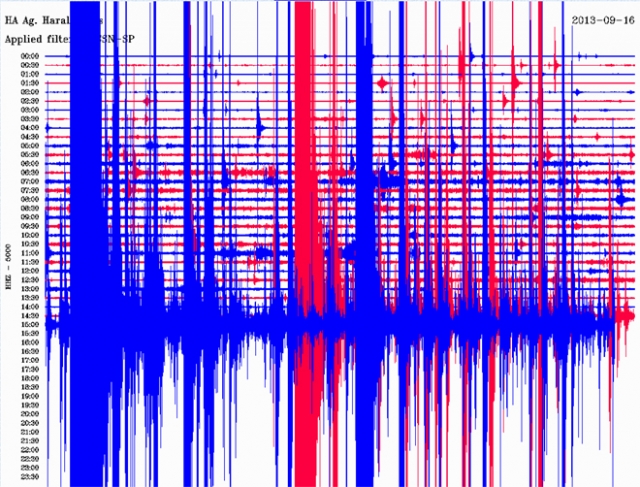Title photo: imerisia.gr; photos: zougla.gr
Anastasia Balezdrova
The seismic activity in the region of Amfiklia which started in August is still bothering the residents. After the first earthquake of 5.1 on the Richter scale, over 60 houses in different villages in the area of Fthiotida were declared unsuitable for occupation.
Despite the expectations of the people that this was the main earthquake, the aftershocks were no less tangible. After the two earthquakes of 4.5 and 4.8 on the Richter scale registered on Monday, two consecutive earthquakes of 3.9 on the Richter scale and of 4.2 rocked the region today at 8:46 am and 10:39 am respectively. The first earthquake was followed by over 1,300 aftershocks, the magnitude of 900 of which was between 1 and 1.2 on the Richter scale. In six cases, however, it was over 4 on the Richter scale.

Seismologists are carefully monitoring the seismic activity in the region of Amfiklia and no one dares to state whether the earthquake on 7 August was the main one or if a stronger one will follow it. At the same time, they are urging the residents and the local authorities to be on the alert and to continue the inspections of the public and residential buildings that have been damaged.
GRReporter turned to seismologist Konstantinos Papazahos who defines the seismic activity as normal for the particular region.
Mr. Papazahos, how would you comment on the high seismic activity in Greece?
I would not say that the seismic activity in Greece is high. The phenomenon in the region of Amfiklia, which we have been monitoring, is local. The region lies on faults and we know that they cause such earthquakes. The seismic activity there began on 7 August and, apparently, the process is not finished. Therefore, the local authorities and residents should take the necessary security measures. When the seismic activity is in the process of development it is very likely that shocks of the same or higher magnitude might follow. Therefore, security measures must be taken such as for the residents to avoid using residential buildings which have suffered damage.
An article in the French daily Le Monde indicated that there would be a strong earthquake in the region of Greece. Is this a real danger, according to your observations?
This is a huge misunderstanding. The media have incorrectly translated the article from French, disseminating that soon in Greece there would be an earthquake of 9 on the Richter scale.
In fact, the article in Le Monde relates something completely different. It is about the judgment of scientists which is based on the fact that modern buildings are constructed so as to withstand earthquakes whose repetition period is approximately 500 years. They describe the expected macroseismic intensities that show the damage caused by an earthquake rather than the magnitude of the earthquake. They are measured on a different scale (European macroseismic scale EMS- 98 – author’s note); on it, 12 indicates a complete devastation.
So, the meaning of the text in Le Monde is that the expected intensities in many regions of Greece, i.e. the damage, are equal to 9. By comparison, the damage caused in the most critical regions by the earthquake of 5.9 on the Richter scale in Athens in 1999 and by the earthquake of 6.6 on the Richter scale in Thessaloniki in 1978 was similar and perhaps greater. Unfortunately, the term "macroseismic intensity of 9" is translated incorrectly as "magnitude of 9" and the period of 500 years is not mentioned at all.

Minor earthquakes have been recently reported in Bulgaria and in the wider Balkan region. Is there a connection between the earthquakes in different countries?
They are not directly connected but certainly, there is a more general connection between them. Both in Bulgaria and Greece earthquakes are mostly due to forces of attraction. Figuratively speaking, it is like an invisible hand pulling the region, nearly tearing it east-west at the same time. The fault in Amfiklia and those in the region of Plovdiv and Sofia are situated almost along the east-west axis. It is the same in Thessaloniki and in many other regions in Greece. In this sense, we can say that they are connected but we cannot say that the same reasons cause them. The low seismic activity recorded in Bulgaria or elsewhere in the Balkans cannot be directly connected with the activity in the region of Amfiklia.
Therefore, you mean that we cannot talk about unusual seismic activity in the Balkans.
That is right. We are talking about an ongoing activity. We do not realize that the annual magnitude in the region of Amfiklia is about 6.3 on the Richter scale. This means that there is at least one earthquake of this magnitude every year. It may happen that there is not one earthquake in a given year but there will be two in the following year. And such an earthquake may be followed by 20 aftershocks of over 5 on the Richter scale.
The region is seismic and earthquakes like yesterday's are perfectly normal. Moreover, if they had happened in a remote unsettled area, the interest in them would not have been so strong. Let me remind you that, during the summer, there was an earthquake of 6 on the Richter scale in the sea south of Crete but we did not pay much attention to it because it was away from the coast.